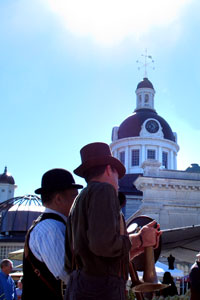Market Square History
Market Square History
Archaeological evidence indicates that an active market has existed on the site now known as Springer Market Square for over 200 years. Its form and function have changed over the years, but its basic purpose remains the same. A traditional centre of trade and commerce, the Kingston market has long provided area vendors a place to sell a range of wares and local residents easy access to foodstuffs and other goods.
Archaeology of the Site
Springer Market Square is a rich archaeological site. Prior to its redevelopment in 2004, archaeological investigation was carried out to determine what material evidence remained of its past. Archaeological testing in 2002 and 2003 uncovered portions of an early 1800s market surface and examples of merchants' wares, stone foundations of the 1840s City Hall Market wing and massive stone steps leading to its lower level, limestone drains, the market weigh house, and water pipes for the horse fountain.
Aboriginal & French Occupation
We know from various historical sources that First Nation's people visited and periodically occupied the waterfront in the area where Springer Market Square is now located, but to date, no archaeological evidence of their lives has been found. The first known structures situated in the Square vicinity date from the French occupation of the area in the 1700s. Military earthworks associated with Fort Frontenac extended east to west across the centre of the Square during the period of the Seven Years War (1756-63). These simple outworks were obliterated during the early years of Loyalist settlement in the late 1700s.
Early Kingston
The Market Square was laid out as part of the original town plan in 1784 and the first market regulations published in 1811. It was the focal point for the local trade in foodstuffs and fuel, all the consumables that supported day-to-day life in early Kingston. It was also where the town sentinel was posted. A small wood-framed T-shaped picket barracks was situated approximately where the south wing of the current City Hall is situated. Another small outbuilding sat where the west wing of City Hall now stands. These military structures existed from the time of the War of 1812 until 1831 when they were auctioned off to the public and dismantled.
The Market in the early 1800s
During the first half of the 19th century, a series of temporary wooden market houses called shambles were erected for the benefit of market vendors. The shambles were extremely flimsy and either burnt or collapsed under their own weight. Kingston antiquarian Edwin Horsey described the market of 1820 "The Market Square was not then of much account ... in the centre was the main guard house, outside of which the bands of the regiments played ...the shambles of frame had been erected for the third time..."
As early as 1834, the District Magistrates envisioned an enhanced use of the site with a combined Market House and Town Hall.
First Capital Period & the late 1800s
In 1840 a catastrophic fire destroyed much of the downtown including the market. Two years later, Kingston Town Council selected architect George Browne's design for a combined Town Hall and Market Hall to be constructed in Market Square. Completed in 1844, the building had an Ontario Street market entrance to facilitate the unloading of goods from boats and the west wing Market Shambles extended all the way to King Street. The new market wing design included a bell tower with a clock and weathervane. In Market Square were a weigh station and a decorative fountain. Market Shambles occupants included butchers, vegetable hucksters, a print shop and a public school library.
In 1865 another fire ravaged Market Square destroying the whole of the west wing. It was later rebuilt in the abbreviated form we see today.
The Market Today
The market has continued to operate in Market Square and, over time, has evolved. The police department shifted its offices and holding cells from the basement of City Hall to the Market Wing in the early 1900s. Gradually municipal office workers replaced market vendors and merchants inside the original Shambles building.
In the early 2000s, cars and trucks have replaced horses and carts, live animals are no longer available for sale and market vendors sell their wares under portable awnings instead of ramshackle shambles structures. What remains consistent is the vibrancy of trade on weekly market days during the spring, summer and autumn, when residents and tourists flock to Springer Market Square seeking fresh produce, meat and baked goods, plants and flowers, craft items and clothing, and antiques and collectibles. The Square remains alive on non-market days with concerts, evening film screenings and other public events. During the winter, skaters enjoy the refrigerated ice surface installed during the 2004 redevelopment of the square.
Acknowledgement: Historical information for this page was provided by the Cataraqui Archaeological Research Foundation (CARF), which conducted an archeological excavation of the area now known as Springer Market Square in 2002-2003.

